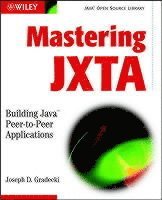
Mastering JXTA Development Upplaga 1
A comprehensive, code-intensive guide to building commercial-quality peer-to-peer applications with JXTA and Java Tens of millions of people use peer-to-peer (P2P) applications such as KaZaA, AOL Instant Messenger, and Distributed.net. These applications harness the idle CPU cycles of their host computers to produce enormous databases of information, build powerful processing engines, and enable communication and file-sharing among users around the world. Previously, P2P applications have been built using proprietary technologies and protocols, forcing developers to start from scratch each time they write a new application. Now JXTA, an open source, P2P development technology, enables developers to build P2P applications using Java, XML, and other industry standards. With this invaluable book, Joseph Gradecki provides a practical guide to building peer-to-peer applications using Java. He provides detailed descriptions of the JXTA technologies and demonstrates how to build real-world applications. This book also includes: Detailed descriptions of the JXTA specification and the Java reference implementation The complete P2P development process, including how to build reusable application frameworks Fully functional example applications, including a distributed computational engine that can utilize the idle CPU power of thousands of remote machines to solve complex problems, and a fault-tolerant, encrypted network storage system The companion Web site includes: All the code listings and complete applications from the book Links to additional JXTA and P2P resources
Upplaga: 1a upplagan
Utgiven: 2002
ISBN: 9780471250845
Förlag: John Wiley & Sons
Format: Häftad
Språk: Engelska
Sidor: 552 st
A comprehensive, code-intensive guide to building commercial-quality peer-to-peer applications with JXTA and Java Tens of millions of people use peer-to-peer (P2P) applications such as KaZaA, AOL Instant Messenger, and Distributed.net. These applications harness the idle CPU cycles of their host computers to produce enormous databases of information, build powerful processing engines, and enable communication and file-sharing among users around the world. Previously, P2P applications have been built using proprietary technologies and protocols, forcing developers to start from scratch each time they write a new application. Now JXTA, an open source, P2P development technology, enables developers to build P2P applications using Java, XML, and other industry standards. With this invaluable book, Joseph Gradecki provides a practical guide to building peer-to-peer applications using Java. He provides detailed descriptions of the JXTA technologies and demonstrates how to build real-world applications. This book also includes: Detailed descriptions of the JXTA specification and the Java reference implementation The complete P2P development process, including how to build reusable application frameworks Fully functional example applications, including a distributed computational engine that can utilize the idle CPU power of thousands of remote machines to solve complex problems, and a fault-tolerant, encrypted network storage system The companion Web site includes: All the code listings and complete applications from the book Links to additional JXTA and P2P resources
Begagnad bok (0 st)
Varje vecka tillkommer tusentals nya säljare. Bevaka boken så får du meddelande när den finns tillgänglig igen.



